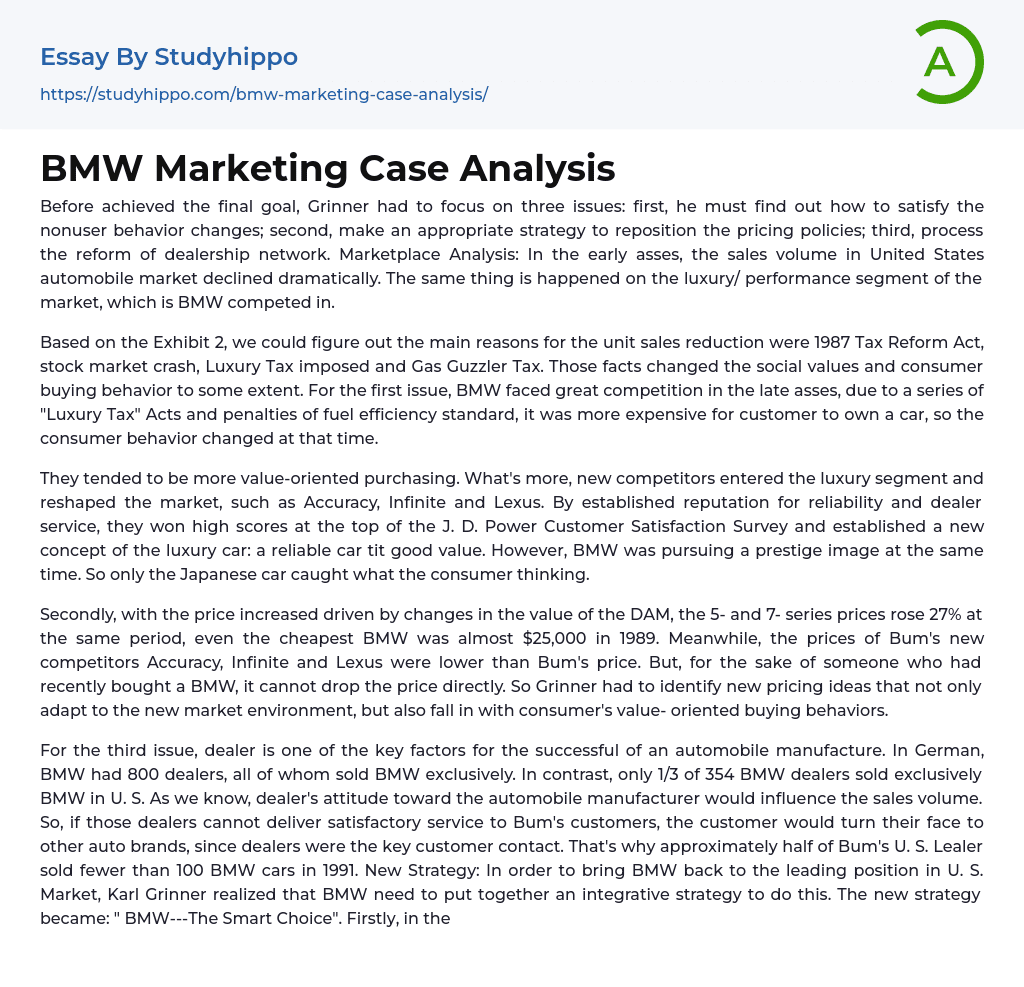
Before achieving the ultimate objective, Grinner had to tackle three challenges: firstly, finding a solution for accommodating changes in nonuser behavior; secondly, developing an appropriate strategy for repositioning pricing policies; and thirdly, implementing reforms in the dealership network.
During the initial assessment phase, there was a significant decrease in sales volume within the United States automobile market and specifically in the luxury/performance segment where BMW operated. According to Exhibit 2, this decline in unit sales was primarily influenced by various factors such as the 1987 Tax Reform Act, stock market crash, Luxury Tax, and Gas Guzzler Tax. These factors had some impact on social values and consumer buying behavior.
As a result of multiple "Luxury Tax" Acts and penalties associated with fuel efficiency standards, BMW faced intense competition durin
...g the later assessment period. The cost of car ownership increased for customers which led to shifts in consumer behavior. Customers became more focused on value when making purchasing decisions. Additionally, new competitors like Accuracy, Infinite, and Lexus entered the luxury segment and reshaped the market by establishing themselves as reliable brands offering exceptional dealer service. These competitors received high ratings on the J.D. Power Customer Satisfaction Survey while introducing a new concept of luxury cars being both dependable vehicles with great value.
However, BMW also wanted to maintain its prestigious image. The only Japanese car that caught the attention of consumers was the one made by BMW. Additionally, due to changes in DAM value, the prices of the 5- and 7-series increased by 27% during this time. Even the least expensive BMW model in 1989 had a price tag of almost $25,000. In comparison, competitors like
Accuracy, Infinite, and Lexus had lower prices than BMW. However, BMW couldn't simply lower their prices for existing customers. This led Grinner to search for new pricing ideas that would adapt to the changing market environment and align with consumer's value-oriented buying behaviors.
The third issue involved BMW dealerships, which played a crucial role in the company's success. In Germany, all 800 dealers exclusively sold BMW vehicles. In contrast, only one-third of the 354 U.S.-based BMW dealerships exclusively sold BMW cars. The attitude of these dealers towards the manufacturer greatly influenced sales volume. If they didn't provide satisfactory service to customers, those customers were likely to turn to other auto brands since dealers served as a key point of contact for them. This explains why roughly half of BMW's U.S. dealerships sold fewer than 100 BMW cars in 1991.
To regain its leading position in the U.S. market, Karl Grinner realized that an integrative strategy was necessary and implemented "BMW---The Smart Choice" as their new strategy choice.Firstly,the focus shifted more towards providing consumers with a personalized experienceCompared to Lexus, BMW's focus is on being the Ultimate Driving Machine, which means their cars aim to enhance the driver's skills. In contrast, Lexus prioritizes providing extremely comfortable driving conditions but controls the consumer's driving experience. To address this, BMW introduced the Better-car/Better-Driver concept to consumers, encouraging them to not only consider reliability, fuel efficiency, and comfort but also prioritize the overall driving experience (as seen in Exhibit 1 where this approach strongly appeals to younger buyers who have significant purchasing power).
In terms of pricing strategy, Grinner took into account the composition of their product line and considered the "price
ladder." To tackle pricing/value concerns in the U.S., BMW introduced lower-priced models. The introduction of a new product offering priced at $19,900 makes it the most affordable among all BMW cars available in the U.S. Additionally, while featuring all-new engines, prices for models such as 325 and 740 are only slightly higher (6% and 2%, respectively) than their predecessors'.
Furthermore, to improve customer service satisfaction levels,BMW implemented three steps aimed at reforming its dealership network. Firstly,a team of area managers was appointed to oversee each dealer and assist them in enhancing performance. Secondly,the Dealer Operating System was created by BMW to ensure consistent regulations throughout car sales processes and services provided at dealerships.Additionally,a bonus system was implemented for dealers who achieved high sales volumes while maintaining excellent levels of customer satisfaction.BMW focused on strengthening its exclusive dealer network by emphasizing that dealers should only sell BMW vehicles. This approach helped BMW improve its "Customer Care" programs by closely regulating the dealership network. The overarching goal was to establish a high-quality franchise that prioritized customer satisfaction and offered prestige, enjoyment, and excitement. Additionally, BMW aimed to build trust among customers and ensure that investing in their vehicles was a wise choice.
- Renault essays
- Truck essays
- chrysler essays
- The city essays
- Racing essays
- Advertising essays
- Audience Theory essays
- Competitor Analysis essays
- Consumer essays
- Marketing Management essays
- Marketing Mix essays
- Marketing Plan essays
- Marketing Research essays
- Marketing Strategy essays
- Point Of Sale essays
- Price essays
- Procurement essays
- Product essays
- Product Differentiation essays
- Promotion essays
- Promotion And Marketing Communications essays
- Retailing essays
- Trademark essays
- Anheuser-busch essays
- Brands essays
- Detergent essays
- Product Placement essays
- Research Design essays
- New Product Development essays
- Advertisement essays
- Brand essays
- Sales Promotion essays
- Advertising campaign essays
- Consumer behaviour essays
- Offer And Acceptance essays
- Wal-Mart essays
- Discover essays
- Gas prices essays
- Adidas essays
- Amazon essays
- Apple essays
- Bmw essays
- British Airways essays
- Burger King essays
- Coca-Cola essays
- Company essays
- Costco essays
- Dell essays
- Ebay essays
- Enron essays



